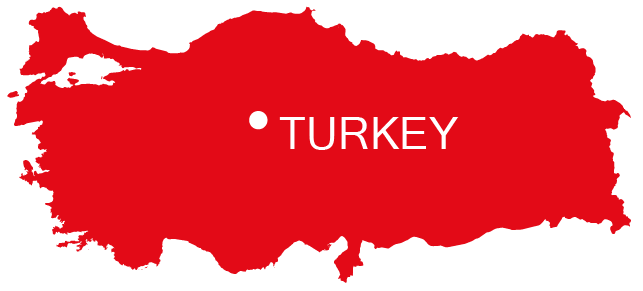Language History
Turkish is a member of the Turkic language family and the descendant of Ottoman Turkish and Old Anatolian Turkish from the late 11th century AD. After much influence in words and grammar from languages like Arabic and Persian, Old Turkish evolved and was soon written in the Arabic script. It was after the founding of the Turkish Republic in 1923 when the Latin alphabet took over the Arabic script in 1928. The language was greatly improved and even after several disputes, Turkish vocabulary was stripped of any foreign elements. Eventually, a new literary language was formed leading to what is known today as modern Turkish.
[/vc_pangea_service_desc_block][/vc_column][/vc_row][vc_row css=”.vc_custom_1621878711689{background-color: #f1f2f0 !important;}” el_class=”bg-grey”][vc_column css=”.vc_custom_1558445967850{margin-top: -90px !important;margin-bottom: -70px !important;}”][vc_pangea_custom_block layout=”center” button_color=”#d15f45″ content_font=”Open Sans” button_popup_form=”” button_text=”Get in Touch” button_link=”url:https%3A%2F%2Fportal.stg-wpml.pangea.global%2Frequest-quote%2F|||”]Turkish is believed to be spoken by approximately 78 million people in the world, according to Babbel. 75 million of these speak Turkish as a first language, while the remaining speak it as a second or third.
[/vc_pangea_custom_block][/vc_column][/vc_row][vc_row css=”.vc_custom_1557920359208{margin-bottom: -50px !important;background-color: #ffffff !important;}”][vc_column css=”.vc_custom_1557920302161{margin-top: -50px !important;margin-bottom: -30px !important;}”][vc_pangea_custom_block layout=”center” heading_font=”Futura Std” content_font=”Open Sans” title=”Where is Turkish Spoken?”]Turkish is the official language of Turkey, where it is spoken by more than 74 million people. Nevertheless, it is also spoken in several other countries around the world such as Germany (1.5 million speakers), Bulgaria, (600,000 speakers), Cyprus (300,000 speakers), Netherlands (50,000 speakers), France (221,000), Austria (200,000), Uzbekistan (130,000), the U.S (116,000), Belgium (113,000), Greece, Macedonia, Romania, Kazakhstan, Iraq, Serbia, Switzerland and Albania.Source: Babbel.com
 [/vc_pangea_custom_block][/vc_column][/vc_row][vc_row el_id=”benefits-container” css=”.vc_custom_1621878717432{margin-top: px !important;background-color: #f1f2f0 !important;}” el_class=”bg-grey”][vc_column width=”1/2″ css=”.vc_custom_1563346550878{margin-top: 50px !important;margin-bottom: 50px !important;}”][vc_pangea_custom_block layout=”center” background_color=”” content_font=”Open Sans” css_custom_id=”text-near-bubble” title=”FACT” background_image=”5847″]Did you know that Turkish is linguistically similar to Japanese, Korean and Hungarian?
[/vc_pangea_custom_block][/vc_column][/vc_row][vc_row el_id=”benefits-container” css=”.vc_custom_1621878717432{margin-top: px !important;background-color: #f1f2f0 !important;}” el_class=”bg-grey”][vc_column width=”1/2″ css=”.vc_custom_1563346550878{margin-top: 50px !important;margin-bottom: 50px !important;}”][vc_pangea_custom_block layout=”center” background_color=”” content_font=”Open Sans” css_custom_id=”text-near-bubble” title=”FACT” background_image=”5847″]Did you know that Turkish is linguistically similar to Japanese, Korean and Hungarian?
Did you know that Turkish is linguistically similar to Japanese, Korean and Hungarian?[/vc_pangea_custom_block][/vc_column][vc_column width=”1/2″ css=”.vc_custom_1571832062238{margin-top: 63px !important;}”][vc_pangea_custom_block layout=”center” background_color=”” content_font=”Open Sans” css_custom_id=”text-near-bubble” title=”Did you Know?” background_image=”5847″]Turkish has influenced the English language in many ways! Words such as “yogurt”, “kayak” and “kiosk” all originate from Turkish![/vc_pangea_custom_block][/vc_column][/vc_row][vc_row css=”.vc_custom_1621878723205{margin-top: -30px !important;padding-top: 50px !important;background-color: #f1f2f0 !important;}” el_class=”bg-grey”][vc_column css=”.vc_custom_1564058015924{margin-top: -30px !important;}”][vc_pangea_quote_block font=”Futura Std” quote_text=”“The oldest records of written Turkish were found on stone monuments in Central Asia, the Orhun Yenisey and Talas regions in Mongolia, dating back to 725, 732 and 735 AD.””][/vc_column][/vc_row][vc_row css=”.vc_custom_1591778422176{margin-top: 50px !important;background-color: #ffffff !important;}”][vc_column css=”.vc_custom_1565182107210{margin-top: -100px !important;margin-bottom: -20px !important;}”][vc_pangea_custom_block layout=”center” title=”4 Easy Phrases in Turkish! “][/vc_pangea_custom_block][/vc_column][/vc_row][vc_row el_id=”benefits-container”][vc_column css=”.vc_custom_1591778438868{margin-top: -50px !important;}”][vc_wp_text title=” “]
| Turkish | English |
|---|---|
| Günaydın | Good Morning |
| Nasılsınız? (frm)/ Nasılsın? (inf) | How are you? |
| İyi günler! | Have a nice day! |
| Teşekkür ederim | Thank you |
Turkey Population:
82,961,805
Internet Users:
69,107,183
Penetration:
83.3%
As of 2019. Source:
www.internetworldstats.com
• Unlike English sentences, which are more verb-centric, Turkish sentences are typically more noun / subject centric.
• Remember that Turkish verbs are placed at the end of a sentence!
• Bear in mind that two vowels or two consonants hardly follow each other.
• Don’t forget that when attaching a suffix to a proper noun, you must use an apostrophe to separate the suffix from the word.
• Turkish has three different buffer letters – they are ‘y’,’n’ and ‘s’.[/vc_pangea_custom_block][/vc_column][/vc_row][vc_row css=”.vc_custom_1565180313749{background-color: #f1f2f0 !important;}”][vc_column css=”.vc_custom_1558438241711{margin-top: -50px !important;}”][vc_pangea_custom_block layout=”center” content_font=”Open Sans”]Are you looking for professional Turkish translation services? Get in touch with Pangea Global! We’ll hook you up with one of our professional linguists who will provide you with accurate and reliable Turkish localization services, copywriting, voice overs and more![/vc_pangea_custom_block][/vc_column][/vc_row][vc_row css=”.vc_custom_1621878734785{background-color: #f1f2f0 !important;}” el_class=”bg-grey”][vc_column css=”.vc_custom_1557924920503{margin-top: -30px !important;margin-bottom: 40px !important;}”][vc_pangea_cta_button button_text=”Get In Touch” button_link=”url:https%3A%2F%2Fstg-wpml.stg-wpml.pangea.global%2Fquote%2F|||”][/vc_column][/vc_row]




